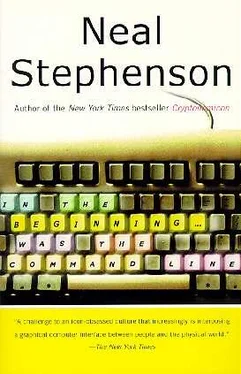Neal Stephenson - In the Beginning was the Command Line
Здесь есть возможность читать онлайн «Neal Stephenson - In the Beginning was the Command Line» весь текст электронной книги совершенно бесплатно (целиком полную версию без сокращений). В некоторых случаях можно слушать аудио, скачать через торрент в формате fb2 и присутствует краткое содержание. Жанр: Фантастика и фэнтези, на английском языке. Описание произведения, (предисловие) а так же отзывы посетителей доступны на портале библиотеки ЛибКат.
- Название:In the Beginning was the Command Line
- Автор:
- Жанр:
- Год:неизвестен
- ISBN:нет данных
- Рейтинг книги:5 / 5. Голосов: 1
-
Избранное:Добавить в избранное
- Отзывы:
-
Ваша оценка:
- 100
- 1
- 2
- 3
- 4
- 5
In the Beginning was the Command Line: краткое содержание, описание и аннотация
Предлагаем к чтению аннотацию, описание, краткое содержание или предисловие (зависит от того, что написал сам автор книги «In the Beginning was the Command Line»). Если вы не нашли необходимую информацию о книге — напишите в комментариях, мы постараемся отыскать её.
In the Beginning was the Command Line — читать онлайн бесплатно полную книгу (весь текст) целиком
Ниже представлен текст книги, разбитый по страницам. Система сохранения места последней прочитанной страницы, позволяет с удобством читать онлайн бесплатно книгу «In the Beginning was the Command Line», без необходимости каждый раз заново искать на чём Вы остановились. Поставьте закладку, и сможете в любой момент перейти на страницу, на которой закончили чтение.
Интервал:
Закладка:
Never mind how Microsoft used to make money; today, it is making its money on a kind of temporal arbitrage. "Arbitrage," in the usual sense, means to make money by taking advantage of differences in the price of something between different markets. It is spatial, in other words, and hinges on the arbitrageur knowing what is going on simultaneously in different places. Microsoft is making money by taking advantage of differences in the price of technology in different times. Temporal arbitrage, if I may coin a phrase, hinges on the arbitrageur knowing what technologies people will pay money for next year, and how soon afterwards those same technologies will become free. What spatial and temporal arbitrage have in common is that both hinge on the arbitrageur's being extremely well-informed; one about price gradients across space at a given time, and the other about price gradients over time in a given place.
So Apple/Microsoft shower new features upon their users almost daily, in the hopes that a steady stream of genuine technical innovations, combined with the "I want to believe" phenomenon, will prevent their customers from looking across the road towards the cheaper and better OSes that are available to them. The question is whether this makes sense in the long run. If Microsoft is addicted to OSes as Apple is to hardware, then they will bet the whole farm on their OSes, and tie all of their new applications and technologies to them. Their continued survival will then depend on these two things: adding more features to their OSes so that customers will not switch to the cheaper alternatives, and maintaining the image that, in some mysterious way, gives those customers the feeling that they are getting something for their money.
The latter is a truly strange and interesting cultural phenomenon.
THE INTERFACE CULTURE
A few years ago I walked into a grocery store somewhere and was presented with the following tableau vivant: near the entrance a young couple were standing in front of a large cosmetics display. The man was stolidly holding a shopping basket between his hands while his mate raked blister-packs of makeup off the display and piled them in. Since then I've always thought of that man as the personification of an interesting human tendency: not only are we not offended to be dazzled by manufactured images, but we like it. We practically insist on it. We are eager to be complicit in our own dazzlement: to pay money for a theme park ride, vote for a guy who's obviously lying to us, or stand there holding the basket as it's filled up with cosmetics.
I was in Disney World recently, specifically the part of it called the Magic Kingdom, walking up Main Street USA. This is a perfect gingerbready Victorian small town that culminates in a Disney castle. It was very crowded; we shuffled rather than walked. Directly in front of me was a man with a camcorder. It was one of the new breed of camcorders where instead of peering through a viewfinder you gaze at a flat-panel color screen about the size of a playing card, which televises live coverage of whatever the camcorder is seeing. He was holding the appliance close to his face, so that it obstructed his view. Rather than go see a real small town for free, he had paid money to see a pretend one, and rather than see it with the naked eye he was watching it on television.
And rather than stay home and read a book, I was watching him.
Americans' preference for mediated experiences is obvious enough, and I'm not going to keep pounding it into the ground. I'm not even going to make snotty comments about it--after all, I was at Disney World as a paying customer. But it clearly relates to the colossal success of GUIs and so I have to talk about it some. Disney does mediated experiences better than anyone. If they understood what OSes are, and why people use them, they could crush Microsoft in a year or two.
In the part of Disney World called the Animal Kingdom there is a new attraction, slated to open in March 1999, called the Maharajah Jungle Trek. It was open for sneak previews when I was there. This is a complete stone-by-stone reproduction of a hypothetical ruin in the jungles of India. According to its backstory, it was built by a local rajah in the 16th Century as a game reserve. He would go there with his princely guests to hunt Bengal tigers. As time went on it fell into disrepair and the tigers and monkeys took it over; eventually, around the time of India's independence, it became a government wildlife reserve, now open to visitors.
The place looks more like what I have just described than any actual building you might find in India. All the stones in the broken walls are weathered as if monsoon rains had been trickling down them for centuries, the paint on the gorgeous murals is flaked and faded just so, and Bengal tigers loll amid stumps of broken columns. Where modern repairs have been made to the ancient structure, they've been done, not as Disney's engineers would do them, but as thrifty Indian janitors would--with hunks of bamboo and rust-spotted hunks of rebar. The rust is painted on, or course, and protected from real rust by a plastic clear-coat, but you can't tell unless you get down on your knees.
In one place you walk along a stone wall with a series of old pitted friezes carved into it. One end of the wall has broken off and settled into the earth, perhaps because of some long-forgotten earthquake, and so a broad jagged crack runs across a panel or two, but the story is still readable: first, primordial chaos leads to a flourishing of many animal species. Next, we see the Tree of Life surrounded by diverse animals. This is an obvious allusion (or, in showbiz lingo, a tie-in) to the gigantic Tree of Life that dominates the center of Disney's Animal Kingdom just as the Castle dominates the Magic Kingdom or the Sphere does Epcot. But it's rendered in historically correct style and could probably fool anyone who didn't have a Ph.D. in Indian art history.
The next panel shows a mustachioed H. sapiens chopping down the Tree of Life with a scimitar, and the animals fleeing every which way. The one after that shows the misguided human getting walloped by a tidal wave, part of a latter-day Deluge presumably brought on by his stupidity.
The final panel, then, portrays the Sapling of Life beginning to grow back, but now Man has ditched the edged weapon and joined the other animals in standing around to adore and praise it.
It is, in other words, a prophecy of the Bottleneck: the scenario, commonly espoused among modern-day environmentalists, that the world faces an upcoming period of grave ecological tribulations that will last for a few decades or centuries and end when we find a new harmonious modus vivendi with Nature.
Taken as a whole the frieze is a pretty brilliant piece of work. Obviously it's not an ancient Indian ruin, and some person or people now living deserve credit for it. But there are no signatures on the Maharajah's game reserve at Disney World. There are no signatures on anything, because it would ruin the whole effect to have long strings of production credits dangling from every custom-worn brick, as they do from Hollywood movies.
Among Hollywood writers, Disney has the reputation of being a real wicked stepmother. It's not hard to see why. Disney is in the business of putting out a product of seamless illusion--a magic mirror that reflects the world back better than it really is. But a writer is literally talking to his or her readers, not just creating an ambience or presenting them with something to look at; and just as the command-line interface opens a much more direct and explicit channel from user to machine than the GUI, so it is with words, writer, and reader.
The word, in the end, is the only system of encoding thoughts--the only medium--that is not fungible, that refuses to dissolve in the devouring torrent of electronic media (the richer tourists at Disney World wear t-shirts printed with the names of famous designers, because designs themselves can be bootlegged easily and with impunity. The only way to make clothing that cannot be legally bootlegged is to print copyrighted and trademarked words on it; once you have taken that step, the clothing itself doesn't really matter, and so a t-shirt is as good as anything else. T-shirts with expensive words on them are now the insignia of the upper class. T-shirts with cheap words, or no words at all, are for the commoners).
Читать дальшеИнтервал:
Закладка:
Похожие книги на «In the Beginning was the Command Line»
Представляем Вашему вниманию похожие книги на «In the Beginning was the Command Line» списком для выбора. Мы отобрали схожую по названию и смыслу литературу в надежде предоставить читателям больше вариантов отыскать новые, интересные, ещё непрочитанные произведения.
Обсуждение, отзывы о книге «In the Beginning was the Command Line» и просто собственные мнения читателей. Оставьте ваши комментарии, напишите, что Вы думаете о произведении, его смысле или главных героях. Укажите что конкретно понравилось, а что нет, и почему Вы так считаете.








